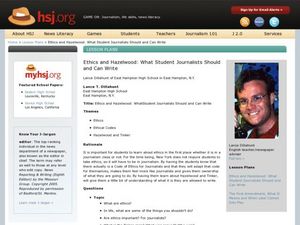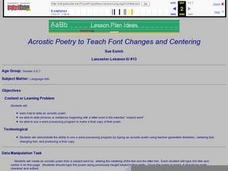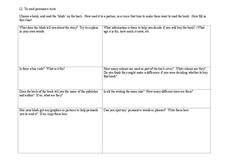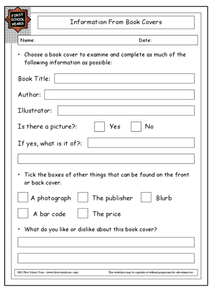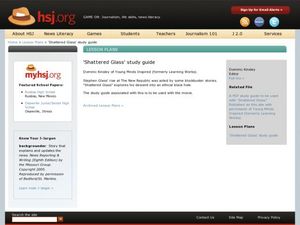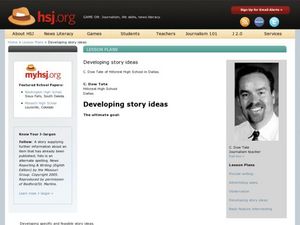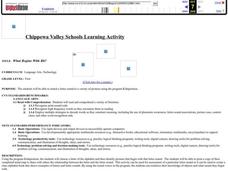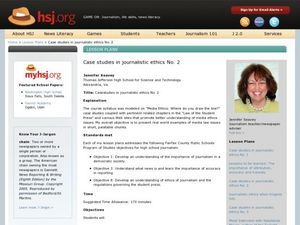Curated OER
Count the Images!
Based on a selection of images, learners create a bar graph depicting how many of each image is shown. There are two graphs, each with three images to chart. After they are finished, scholars can analyze the data and draw conclusions. To...
Curated OER
Forming a Code of Ethics
High schoolers discuss and create a code of ethics for their student newspaper.
Curated OER
Learning ASL: Lesson 9
Here is lesson 9 in an extensive series on teaching and learning ASL. Discuss code switching, numerical incorporation, and noun based vocabulary. Then, click on the blue links to view ASL in action. Each link takes you to a printable...
Curated OER
Caesar Ciphers: An Introduction to Cryptography
Students brainstorm and discuss the concept of cryptography, the science of secrets in today's world and then focus on a system for sending secret messages used by Julius Caesar. They make a Caesar wheel assessing encrypting and...
ProCon
Drinking Age
Eighteen is the age of adulthood in the United States, but 21 is the legal drinking age. Pupils use the provided website to determine whether the age to legally purchase and consume alcohol should be lowered. They weigh the pros and...
Curated OER
Ethics and Hazelwood: What Journalists Should and Can Write
Students explore the code of ethics in journalism. In this journalism ethics lesson, students use Hazelwood and Tinker to explore journalism ethics. Students compare ethics of journalists and pirates, read a related article, write their...
Curated OER
ESL: A, Many, An, Any, Some, Much
In this ESL vocabulary worksheet, students complete sentences using either a, an, some, any, many or much. A link to audio and HTML code is given.
Curated OER
The Parts of Speech -- Grammar
Students discover the different part of speech. The words are color coded and should help them remember the different parts of speech.
Curated OER
Using Spreadsheets and Graphs
Third graders explore mathematics by utilizing computers. In this graphing lesson, 3rd graders gather class data based on a particular topic such as the "favorite candy" of the class. Students utilize this information and computers to...
Curated OER
Who Do You Know?
Pupils research and describe the contributions of African-American men and women. They write their notes in a Microsoft Word document. They present their information to the class.
Curated OER
Acrostic Poetry to Teach Font Changes and Centering
Young scholars engage in a discussion about how to write an acrostic poem. They demonstate the ability to use a word processor by typing an acrostic poem by following instructions. Word processing skills such as, centering text, changing...
Curated OER
Teaching Ideas and Resources
In this teacher website, teachers have access to a variety of tools and resources. Teachers can utilize plans, lessons, and worksheets in all subject areas.
Curated OER
Use of Lasers
Students explore the use of lasers. In this "lasers" science and career education instructional activity, students search the Internet to find uses for lasers and make a list of companies that use or produce lasers. Students complete a...
Curated OER
Tinker Toys
Students explore various computer items. They describe possible alternative uses for computer technology. Students explore the practice of "reverse engineering." They write an opinion essay on the ethics behind "reverse engineering."
Curated OER
Information from Book Covers
For this book cover information worksheet, learners choose a book cover to examine and respond to 7 questions regarding the cover.
Curated OER
Shattered Glass Study Guide
Students view a movie about ethical journalism and Stephen Glass' rise at The New Republic. In this news ethics instructional activity, students view "Shattered Glass" and explore Glass' descent into an ethical black hole....
Curated OER
To Kill a Mockingbird
Provided here are activities and questions for Part I of To Kill a Mockingbird (although one activity is also included for Part II). Readers study the novel's plot, characters, and setting. I wouldn't recommend using this as the sole...
Curated OER
Developing Story Ideas
Students complete activities to learn how to develop story ideas in journalistic writing. In this story ideas lesson, students learn news value judging criteria, identify language to ask beat sources for story ideas, distinguish story...
Curated OER
What Begins With Bb?
First graders match letter sounds to pictures they represent. In this matching letter sound lesson plan, 1st graders use the computer program Kidspiration to match the letter sounds to the corresponding pictures. This can be used for 1...
Curated OER
What is a Dictionary?
Second graders explore the purpose of a dictionary. In this library media instructional activity, 2nd graders explore My First Dictionary and identify guidewords, entry words, and captions. Students list ways they can use the dictionary.
Curated OER
Case Studies in Journalistic Ethics No. 2
Learners use texts on media ethics and various Web sites to explore real world examples of media law issues. For this media ethics lesson, young scholars examine the Food Lion case using a transcript from...
Curated OER
Open Wide
Students recognize the short vowel o in written and spoken language. Through matching and listening activities, they discriminate the vowel sound /o/ from other phonemes. Students associate the phoneme with its letter representation in...
Other
Canal Kids: Grandes Ingenerates (Big Inventions)
An exploration of four defining scientific inventions/discoveries of recent history: plastic, laser technology, electricity, and bar codes. The history and development of these technologies, along with examples of their application and...





